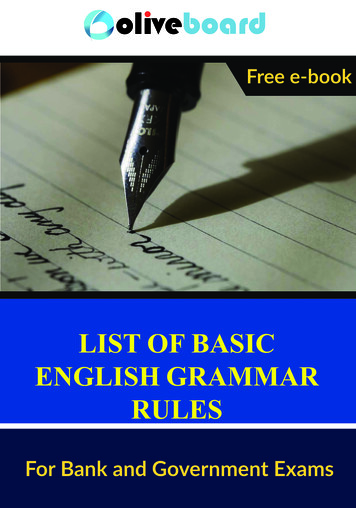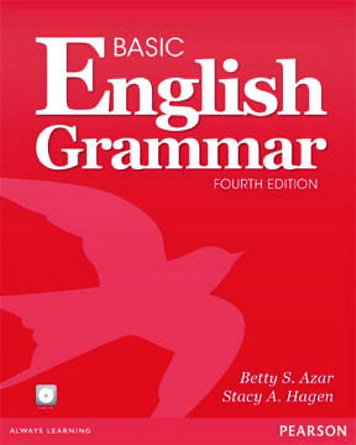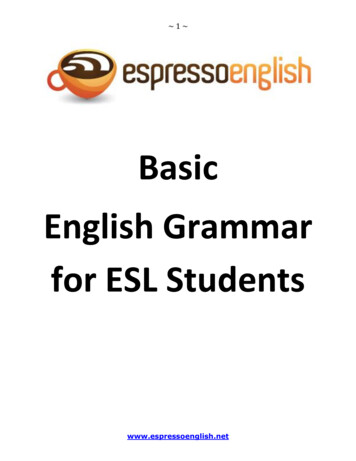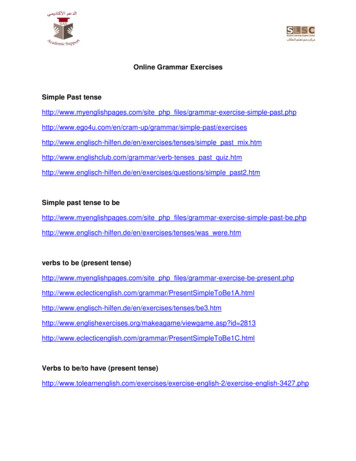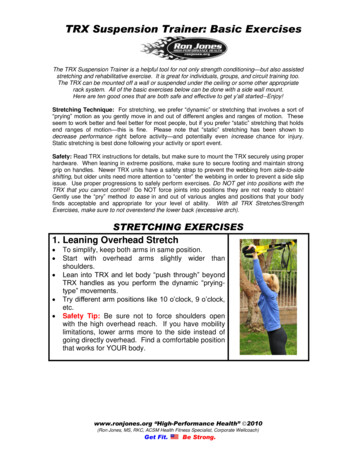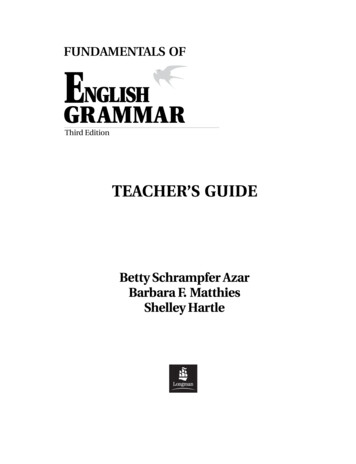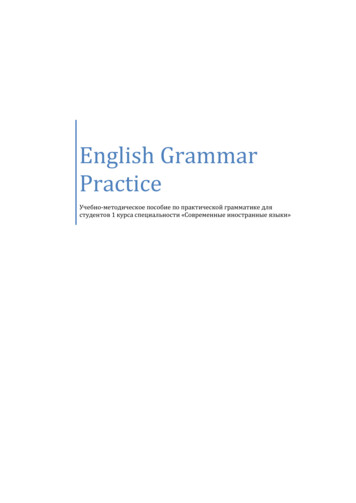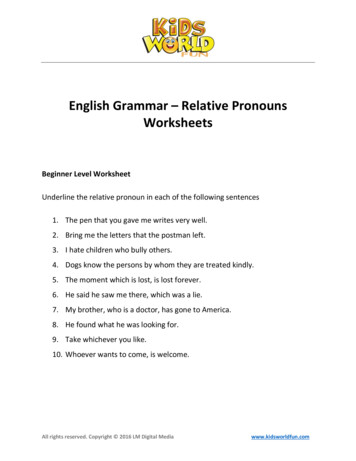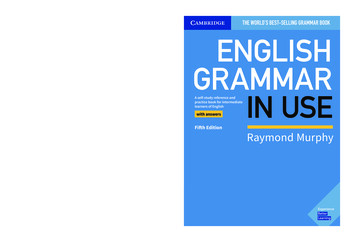
Transcription
Basic English Syntaxwith ExercisesMark NewsonDániel PapGabriella TóthKrisztina SzécsényiMarianna HordósVeronika Vincze
PrefaceLinguists, it has to be admitted, are strange animals. They get very excited about thingsthat the rest of the species seem almost blind to and fail to see what all the fuss isabout. This wouldn’t be so bad if linguists were an isolated group. But they are not,and what’s more they have to teach non-linguists about their subject. One mistake thatlinguists often make is to assume that to teach linguistics, students should be instilledwith the kind of enthusiasm for the subject that linguists themselves have. But noteverybody wants to be a linguist and, as a friend of mine once said, not everybody canbe a linguist.What the dedicated language student wants, however, is not the ability to analysecomplex data from languages in exotic regions of the world, or to produce coherenttheories that explain why you can’t say his being running in a more elegant way thananyone else can. What they want from linguistics is to see what the subject can offerthem in coming to some understanding of how the language that they are studyingworks. It is for these students that this book has been written.This is not to say that this is not a linguistics text. It is, and linguistics permeatesevery single page. But the difference is that it is not trying to tell you how to become alinguist – and what things to get excited about – but what linguistic theory has to offerfor the understanding of the English language. Many introductory text books in syntaxuse language data as a way of justifying the theory, so what they are about is thelinguistic theory rather than the language data itself. A book which was about languagewould do things differently; it would use the theory to justify a certain view of thelanguage under study. We have attempted to write such a book.As part consequence of this, we have adopted a number of strategies. The first iswhat we call the ‘No U-turn’ strategy. If you have ever read an introductory book on alinguistic topic you may have found pages and pages of long and complicatedarguments as to why a certain phenomena must be analysed in such and such a way,only to find in the next chapter that there is actually a better way of doing things bymaking certain other assumptions. This is the sort of thing that linguist find fun. Butstudents often find it confusing and frustrating. So we have attempted to write thisbook without using this strategy. As far as possible, concepts and analyses that areintroduced at some point in the book are not altered at some later point in the book.Obviously, pictures have to be painted a bit at a time to make them understandable andso it isn’t possible to ‘tell the whole truth’ right from the start. But an attempt has beenmade to build up the picture piece by piece, without having to go back and rub outearlier parts of the sketch.Another strategy adopted in the book is to avoid unnecessary formalisms. These arevery useful if you want to understand the workings of a theory to the extent needed to seewhere its weaknesses are and how it needs to be developed to overcome these. But asthis is not our aim, it is not necessary to make students fully aware of how to formalisegrammatical principles. All they need is an understanding of how the principles workand what they predict about the language and this can be put over in a less formal way.
PrefaceThe target audience for the book is BA students, covering the introductory syntaxlevel and going through to more advanced BA level material. For this reason, the bookstarts from the beginning and tries to make as few assumptions as possible aboutlinguistic notions. The first two chapters are a fairly substantial introduction togrammatical concepts both from a descriptive and a theoretical point of view. Thismaterial alone, along with the exercises, could form the basis of an introduction to asyntax course. The latter chapters then address specific aspects of the English languageand how the concepts and grammatical mechanisms introduced in the first twochapters can be applied to these to enable an understanding of why they are as theyare. As the book relies on a ‘building’ process, starting out at basic concepts andadding to these to enable the adequate description of some quite complex and subtlephenomena, we have also provided an extensive glossary, so that if you happen toforget a concept that was introduced in one part of the book and made use of inanother, then it is easy to keep yourself reminded as you read.Obviously, another feature that we hope is more student-friendly is the exercises,of which we have a substantial amount. These range in type and level, from thosewhich you can use to check your understanding of the text, to those which get you tothink about things which follow from the text, but which are not necessarily discussedthere. Some are easy and some will make you think. A fairly unique aspect of the bookis that it also provides model answers to the exercises so that you can check to seewhether you were on the right track with your answer and also for you to learn from:making mistakes is one of the best ways to learn. But if you never know what mistakesyou made, you can’t learn from them. Obviously, the best way to use the exercises andmodel answers is to have a go at the exercises by yourself first and then go and readthe model answers. While you may be able to learn something by reading the modelanswers without having a go at the exercises, it is doubtful that you will get as muchout of them.Finally, a brief word about the team of writers is in order. Although we very muchopted for a division of labour approach to the writing of this book, it has been no lessof a team effort. The text was written by Mark Newson and the exercises prepared byHordós Marianna, Szécsényi Krisztina, Pap Dániel, Tóth Gabriella and VinczeVeronika. Szécsényi Krisztina prepared the glossary. Most of the editing was carriedout by Hordós Marianna, Nádasdi Péter, Szécsényi Krisztina and Szécsényi Tibor.Szécsényi Tibor also has had the responsibility for the electronic version of the bookand managing the forum set up to help us keep in touch. Thanks go to Kenesei Istvánfor his help in setting up the project and for valuable comments on the text and also toMarosán Lajos for equally valuable comments. We are also grateful for theconscientious work and useful remarks of our reviewer, Pelyvás Péter. Marianna andKrisztina are responsible for everything. Without them, nothing would have happened.vi
Table of ContentsPrefacevTable of ContentsviiChapter 1 Grammatical Foundations: Words1144568101115171837475151Chapter 2 Grammatical Foundations: 2Language, Grammar and Linguistic TheoryWord Categories2.1The Lexicon2.2Categories2.3Morphological criteria for determining category2.4Distribution3 A Typology of Word Categories3.1Categorial features3.2Predicates and arguments3.3Grammatical aspects of meaning3.4The Thematic categories3.5Functional Categories3.6Functionally underspecified categoriesCheck QuestionsTest your knowledge1Structure1.1The building blocks of sentences1.2Phrases1.3Sentences within phrases1.4Structural positions1.5Structural terminology1.6Labels1.7Rules2 Grammatical Functions2.1The subject2.2The object2.3Indirect object3 Testing for 3.4Single-word phrasesCheck QuestionsTest your knowledge
Table of ContentsChapter 3 Basic Concepts of Syntactic pter 4 The Determiner Phrase129129137137138142143148148149Chapter 5 Verb 012032032062072092102101X-bar Theory1.1Rewrite rules and some terminology1.2Endocentricity1.3Heads and Complements1.4Specifiers1.5Adjuncts1.6Summary2 Theoretical Aspects of Movement2.1Move2.2D-structure and S-structure2.3Traces2.4Locality Restrictions on movement3 ConclusionCheck QuestionsTest your knowledge12Why the Noun is not the Head of the DPThe Internal Structure of the DP2.1Determiners and Complements2.2The Specifier of the DP2.3Adjunction within the DP3 Multiple Determiners4 ConclusionCheck QuestionsTest your knowledge12Event Structure and AspectVerb Types2.1Unaccusative verbs2.2Light verbs2.3Ergative verbs2.4Transitive verbs2.5Intransitive verbs2.6Multiple complement verbs2.7Phrasal verbs2.8Verbs with clausal complements2.9Summary3 Aspectual Auxiliary Verbs3.1The auxiliary as a dummy3.2The nature of the aspectual morpheme4 Adverbs, PPs and Clausal modifiers4.1Adverbs4.2PP modifiers4.3Clausal modifiers5 ConclusionCheck QuestionsTest your knowledgeviii
Table of ContentsChapter 6 Inflectional Phrases213213218220221225230233238239239240Chapter 7 Complementiser 72273277277278Chapter 8 The Syntax of Non-Finite Clauses28128128128829029429830330730830812The structure of IPThe syntax of inflection2.1Inserting auxiliaries into I2.2Do-insertion2.3Tense and Agreement2.4Movement to tense and I3 Movement to Spec IP4 Adjunction within IP5 ConclusionCheck QuestionsTest your knowledge123The structure of CPThe Clause as CPInterrogative CPs3.1Basic positions within the CP3.2Wh-movement3.3Inversion3.4The interaction between wh-movement and inversion3.5Subject questions4 Relative Clauses4.1The position of the relative clause inside the NP4.2A comparison between relative and interrogative clauses5 Other fronting movements5.1Topicalisation5.2Focus fronting5.3Negative fronting6 ConclusionCheck QuestionsTest your knowledge1Exceptional and Small Clauses1.1Clauses without CP1.2Clauses without IP2 Raising and Control2.1Raising2.2Control3 The Gerund4 ConclusionCheck questionsTest your knowledgeix
Table of ContentsSuggested Answers and raphy455Index456Chapter 1Chapter 2Chapter 3Chapter 4Chapter 5Chapter 6Chapter 7Chapter 8x
Chapter 1Grammatical Foundations:Words1Language, Grammar and Linguistic TheoryThis book attempts to describe some of the basic grammatical characteristics of theEnglish language in a way accessible to most students of English. For this reason westart at the beginning and take as little as possible for granted. Definitions are given forgrammatical concepts when they are first used and there is a glossary at the back of thebook to remind the reader of these as he or she works through it. At the end of eachchapter there are an extensive set of exercises which the student is encouraged toconsider and work through either in class or alone. For those students working alone,we have also provided model answers for the exercises. These are for the student tocheck their understanding of the material supported by the exercises and to offerobservations that the student may have missed.The uninitiated student might be surprised to find that there are many ways todescribe language, not all compatible with each other. In this book we make use of aparticular system of grammatical description based mainly on Government andBinding theory, though it is not our aim to teach this theory and we will very rarelyrefer to it directly. We use the theory to offer a description of English, rather thanusing English to demonstrate the theory. We will spend a short amount of time at thebeginning of the book to state our reasons for choosing this theory, as opposed to anyother, to base our descriptions.Whatever else language might be (e.g. a method of communicating, something toaid thought, a form of entertainment or of aesthetic appreciation) it is first andforemost a system that enables people who speak it to produce and understandlinguistic expressions. The nature of this system is what linguistics aims to discover.But where do we look for this system? It is a common sense point of view thatlanguage exists in people’s heads. After all, we talk of knowing and learninglanguages. This also happens to be the belief of the kind of linguistics that this bookaims to introduce: in a nutshell, the linguistic system that enables us to ‘speak’ and‘understand’ a language is a body of knowledge which all speakers of a particularlanguage have come to acquire.If this is true, then our means for investigating language are fairly limited – wecannot, for instance, subject it to direct investigation, as delving around in someone’sbrain is not only an ethical minefield, but unlikely to tell us very much given ourcurrent level of understanding of how the mind is instantiated in the brain. We are left,therefore, with only indirect ways of investigating language. Usually this works in thefollowing way: we study what the linguistic system produces (grammatical sentenceswhich have certain meanings) and we try to guess what it is that must be going on in
Chapter 1 - Grammatical Foundations: Wordsthe speaker’s head to enable them to do this. As you can imagine, this is not alwayseasy and there is a lot of room for differences of opinion. Some of us might tell youthat that is exactly what makes linguistics interesting.There are however some things we can assume from the outset about the linguisticsystem without even looking too closely at the details of language. First, it seems thatspeakers of a language are able to produce and understand a limitless number ofexpressions. Language simply is not a confined set of squeaks and grunts that havefixed meanings. It is an everyday occurrence that we produce and understandutterances that probably have never been produced before (when was the last time youheard someone say the bishop was wearing a flowing red dress with matching highheeled shoes and singing the Columbian national anthem? – yet you understood it!).But if language exists in our heads, how is this possible? The human head is not bigenough to contain this amount of knowledge. Even if we look at things like brain cellsand synapse connections, etc., of which there
Basic English Syntax with Exercises Mark Newson Dániel Pap Gabriella Tóth Krisztina Szécsényi Marianna Hordós Veronika Vincze . Preface Linguists, it has to be admitted, are strange animals. They get very excited about things that the rest of the species seem almost blind to and fail to see what all the fuss is about. This wouldn’t be so bad if linguists were an isolated group. But they .
